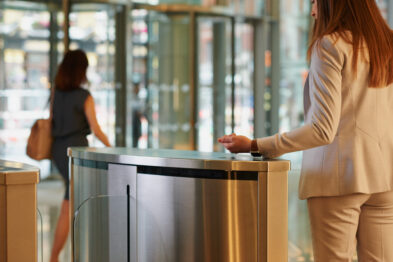Key card access control served a purpose — emphasis on “ed”.
In 1975, while disco bellbottoms were raging in the United States, a Norwegian author, politician and engineer named Tor Sørnes tooled away on what would become the original keycard. He created the keycard while making ice skates and locks for a brand called Ving. The card featured a pattern of 32 possible hole locations and roughly 4.3 billion different combinations. Considering around four billion people lived on earth at the time, the technology sufficed. In 1979 this technology became the Vingcard — the first key card access control.
Access control has come a long way since then. Though the keycard provides more security than it once did, the question any access control manager should ask is: “When will my outdated system become a risk?”
It only takes one Google search to see the plethora of “Database Errors” and “Will Not Encode” issues plaguing keycard administrators. So, as much as we loved disco balls, silk shirts and 32-hole key cards, change is inevitable. In the current digital landscape of cyber threats and system hacking, mobile access control is becoming less of a luxury and more of a necessity. For those building management teams and tenants contemplating cloud-based access control vs. keycards, the process isn’t as painful as one might believe. Here are some reasons to give the “boot” to card access control.
Problems with Magnetic Strips
Meet Bob. Bob has a company access card. Being the responsible employee he is, Bob keeps his access card in a secure place – his wallet.
The problem is glaring to anybody who has waited in a long supermarket line, only to get to the front and realize their credit card is malfunctioning. Cue the cashier with the plastic bag.
Carrying an access card with a magnetic strip near other cards can lead to demagnetization. In a worst-case scenario, Bob will find himself locked out of the office and delayed from starting his important annual reports. Short of a worst-case scenario, building administrators will spend time and resources programming a new keycard for Bob.
Companies often fail to delete credentials of formers employees or lost key cards. If a user loses their keycard, the only way to restore access is by meeting at the office – not ideal with the current pandemic.
Mobile, cloud-based credentialing makes demagnetization a thing of the past. Administrators can send mobile access and make changes to user credentials on the fly, which is the case of the implementation of mobile vs. key card access control for admins.
Rigidity of Key Card Access Control
With Genea Security, administrators can make split-second adjustments to employee access credentials. Access can be expanded or restricted from the clean layout of a mobile dashboard. If Cindy gets a promotion requiring access to new areas in the building, her credentials can be updated instantly. Should a termination occur, administrators can revoke access privileges from anywhere quickly and efficiently.
“Today’s modern enterprise requires the workplace to be dynamic, easy to access and remotely manageable,” state Genea’s Access Control Director, Mike Maxsenti. ” A cloud-based access control system enables your IT and security teams to automate management to increase security…”
Conversely, keycards and their “smartcard” counterparts are only as flexible as they can literally bend. Keycard and smartcard reprogramming must occur onsite. Though smartcards are more secure, they are also more difficult to reprogram. For versatility in and out of the office, cloud-based access control is the solution.
Security Risks: Lost, Stolen and Cloned
Card access control also comes with security risks including cards can be misplaced, stolen or cloned. Cloning devices can be purchased online for as little as $11.
In 2018, Assa Abloy, the parent company of Vingcard, admitted that between 500,000 and 1 million locks using their keycard technology were at risk of a hack. This is a concern for many companies still operating legacy systems.
Unlike on-premise access control, cloud-based systems also allow administrators to manage the systems from a remote location. If a security breach occurs, system administrators can take swift action.
Better Monitoring with Access Control
Genea’s cloud-based access control easily integrates with video and notification platforms like Slack, Microsoft Teams or Cisco Meraki. These provide administrators with instant alerts, which prompt them to act without delay. Cloud-based systems also provide digital logs noting who and when a secure area was accessed.
Those resistant to change should carefully consider how rapidly technology has and will continue to develop. This evolution, along with the recent changes brought about by the pandemic, has sparked demand for cloud-based access control solutions. While some still cling to their beloved keycards, card access control systems may quickly go the way of disco.
If you are looking for a cloud-based access control system designed to work with your existing hardware, schedule a demo to learn how Genea can help.



